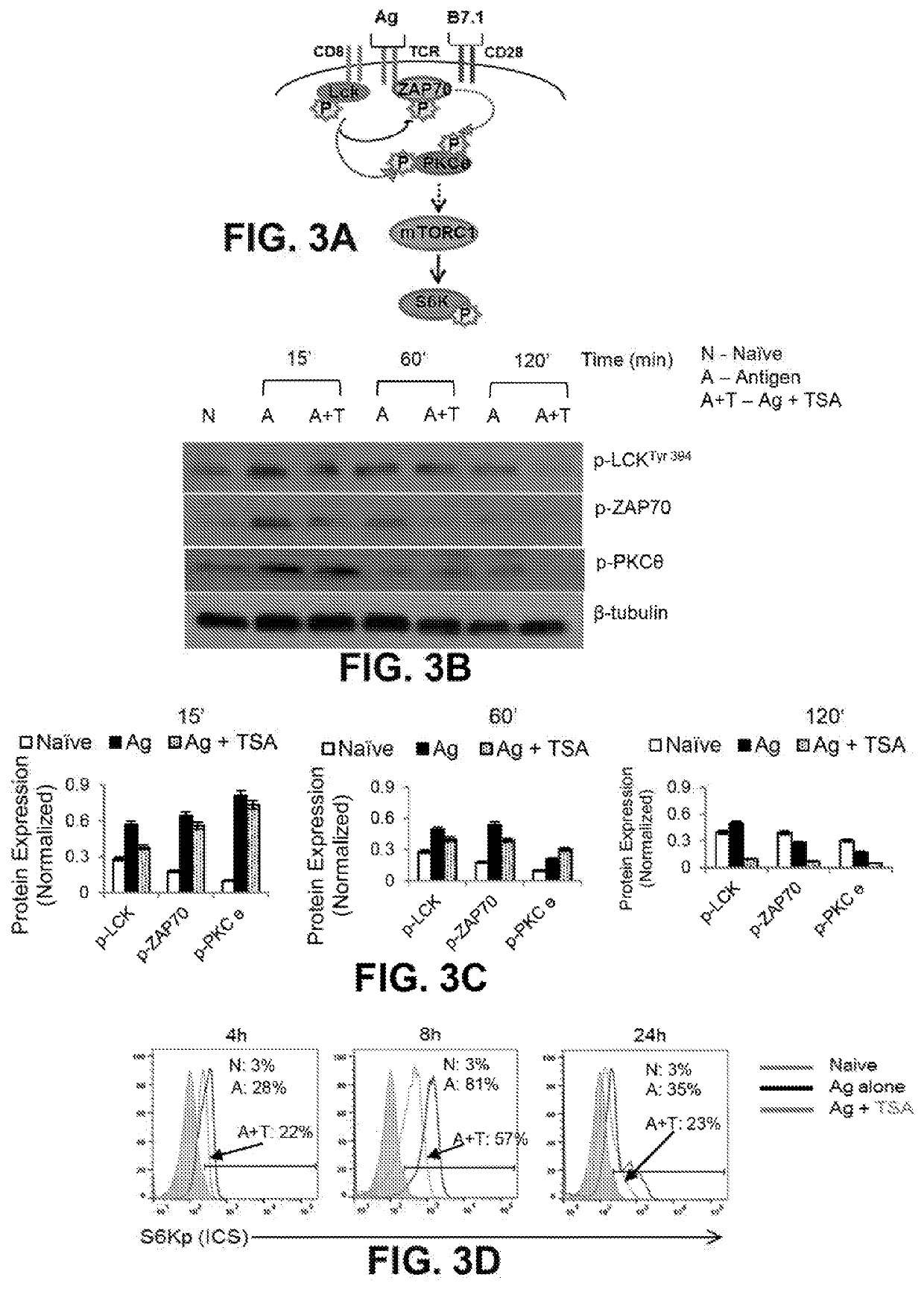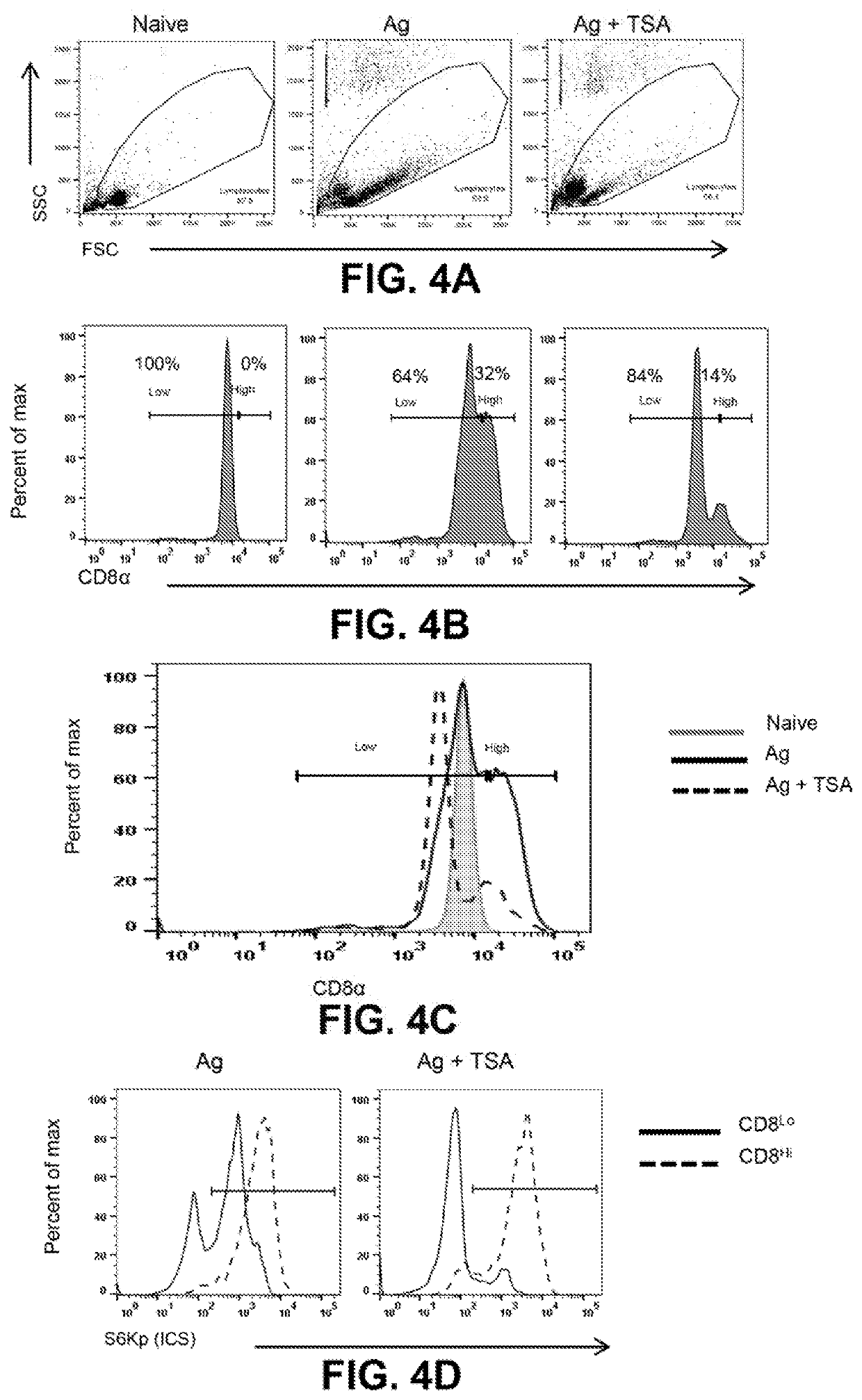Methods of using lysine deacetylase (KDAC) inhibition to generate antigen specific memory t cell responses for durable immunotherapy
a technology of lysine deacetylase and antigen specific memory, which is applied in the field of durable immunotherapy, can solve the problems of affecting the immune system's broad targeting and achieve the effect of durable immunotherapy
- Summary
- Abstract
- Description
- Claims
- Application Information
AI Technical Summary
Benefits of technology
Problems solved by technology
Method used
Image
Examples
example 1
bitors Regulate Antigen-Induced Early Activation of CD8+ T Cells
[0063]Cognate antigen presented by MHC Class 1 to irate CD8+ T cells in the context of co-stimulation and cytokine leads to rapid (2-4 hours) increases in CD69 expression and decreases in CD62L, which indicate antigen induced early T cell activation response. To characterize early activation of T cells, naïve CD8+(OT-I) T cells were reacted with antigen (Ag; latex microspheres bearing H-2Kb-Fc+ / 8 amoni acid cognate peptide / rmB7-1) in vitro for 4 hours, cell surface was stained for CD82L and CD69 expression and evaluated by flow cytometry. The results in FIG. 2 indicate that down-regulation of CD62L, which is due to proteolytic shedding, and up-regulation of CD69, which is due to de novo transcription, occur in an antigen strength (dose) dependent manner (cell to bead ratio-5:1, 1:1 and 1:5, altered peptides produce identical outcomes; data not shown). Strikingly, pre-treatment with the pan KDAC inhibitor, TSA (2.5 ng / ml...
example 2
Inhibition Reduces TCR Proximal Signaling in Antigen Stimulated CD8+ T Cells
[0064]As antigen stimulated CD69 induction has been shown to require PKCθ phosphorylation, the reduction of CD69 expression by KDACi most likely occurs due to dampened early antigen-mediated TCR signaling events. FIG. 3A shows a schematic of early signaling events in naive CD8+ T cells. Western blot analysis was conducted to compare the level of phosphorylation of early TCR signaling proteins, Lck, Zap70, and PKCθ, by TSA pre-treatment of antigen stimulated CD8+ T cells. As shown in FIGS. 3B and 3C, phosphorylation of Lck is dampened by 15 minutes followed by reduction of Zap70 as well as PKCθ in ISA pretreated Ag stimulated CD8+ T cells (Ag+TSA; A+T) compared to the cells treated with antigen alone (Ag alone; A); sequential phosphorylation of Lck, Zap70 and PKCe at 15, 60 and 120 minutes is kinetically dampened by TSA pre-treatment. Since, the energy sensitive kinase mTORC1 serves as an integrative node for...
example 3
Inhibition Augments Asymmetry in Antigen Stimulated CD8+ T Cells
[0065]Accumulating evidence implicates a deterministic role for cellular asymmetry in antigen induced CD8+ T cells division and functional maturation. The KDACi-mediated reduced TCR signaling and mTOR activity were examined to determine their effect on the induction of inherent asymmetry produced in antigen stimulated CD8+ T cells (FIGS. 4A-4D). It was initially observed that upon activation, within 24 h, CD8 expression is up-regulated in a certain percentage of cells. Surprisingly, TSA pre-treated antigen stimulated CD8+ T cells had tuned CD8 expression as compared to antigen alone. TSA renders a lesser proportion of cells to have increased expression of CD8 as compared to Ag alone. This could be attributed to the lower threshold of early activation / TCR signaling cues available to the TSA primed CD8+ T cells.
PUM
| Property | Measurement | Unit |
|---|---|---|
| Time | aaaaa | aaaaa |
| Time | aaaaa | aaaaa |
| Time | aaaaa | aaaaa |
Abstract
Description
Claims
Application Information
 Login to View More
Login to View More - R&D
- Intellectual Property
- Life Sciences
- Materials
- Tech Scout
- Unparalleled Data Quality
- Higher Quality Content
- 60% Fewer Hallucinations
Browse by: Latest US Patents, China's latest patents, Technical Efficacy Thesaurus, Application Domain, Technology Topic, Popular Technical Reports.
© 2025 PatSnap. All rights reserved.Legal|Privacy policy|Modern Slavery Act Transparency Statement|Sitemap|About US| Contact US: help@patsnap.com



